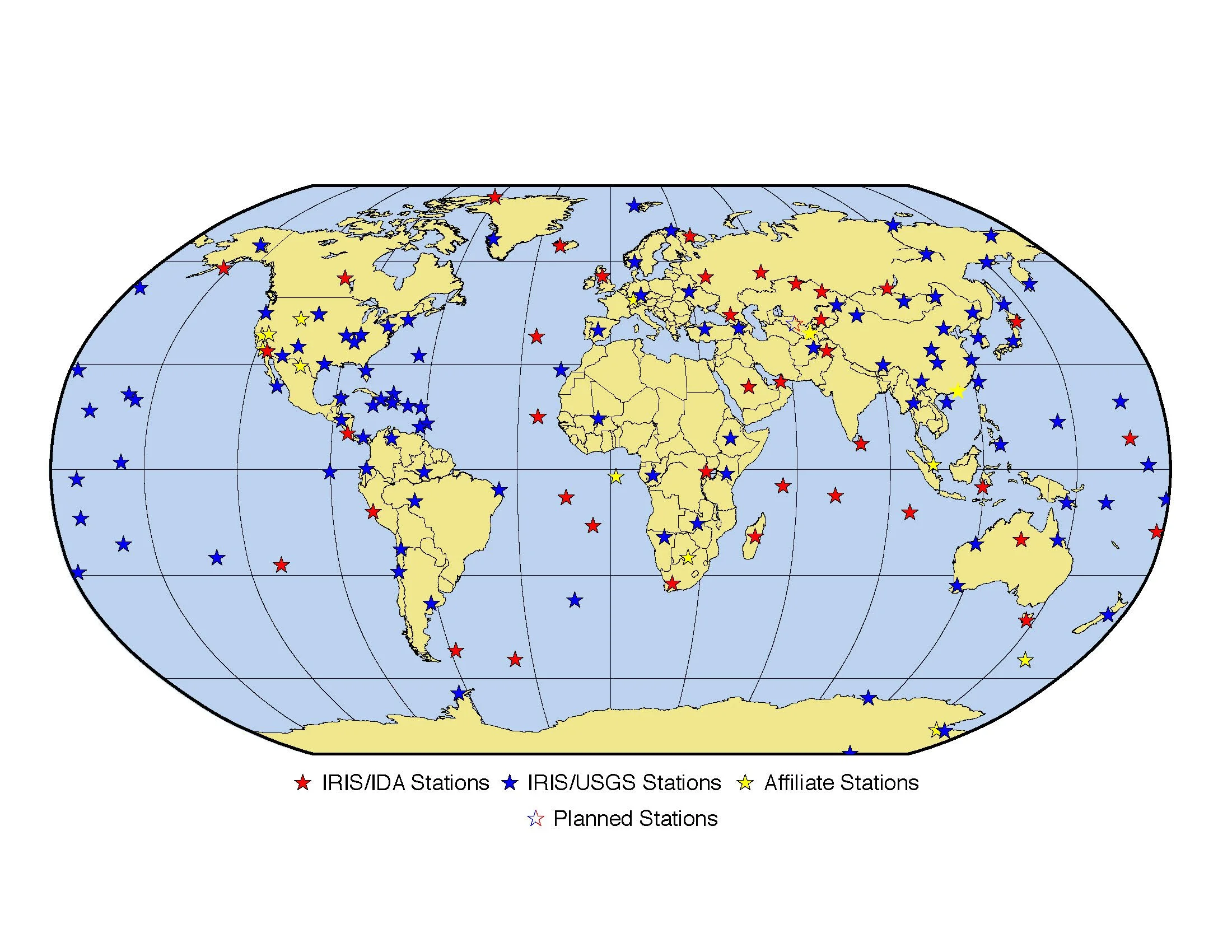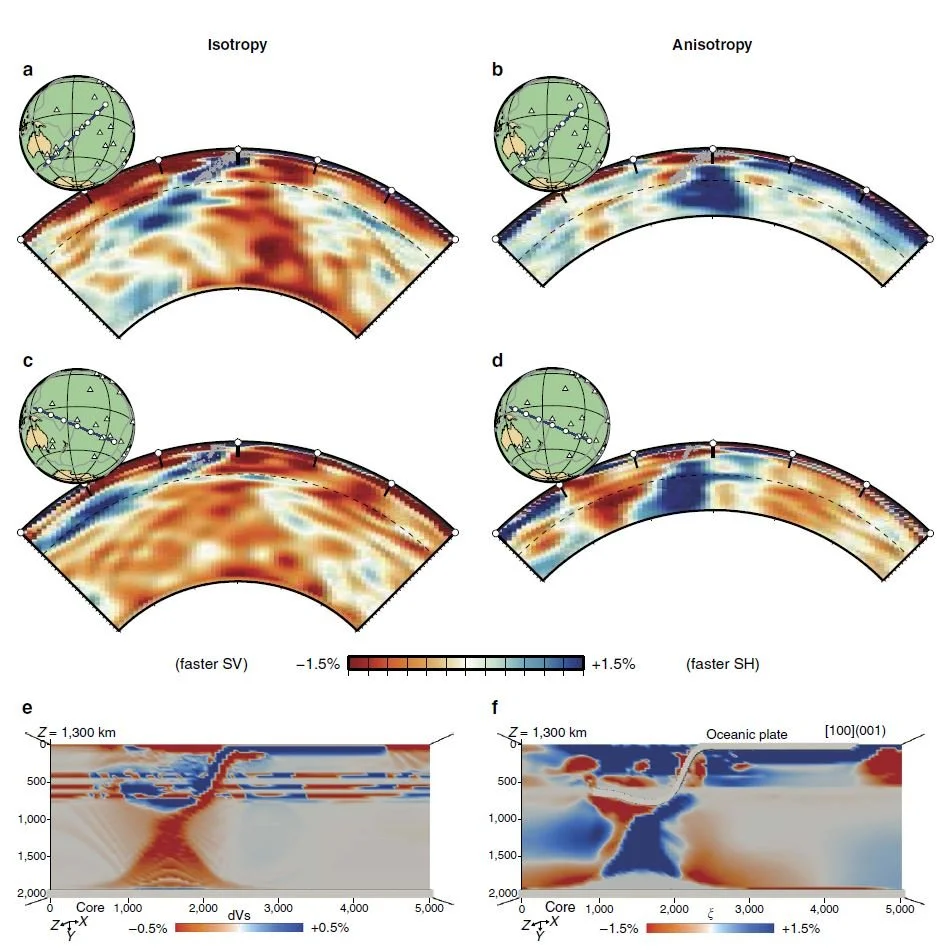Ana Ferreira on Seeing Flows in the Mantle
Listen to the podcast here or wherever you listen to podcasts.
Scroll down for podcast illustrations.
Ana Ferreira is Professor of Seismology at University College, London. She collects and analyzes seismic data from around the world, focusing particularly on the anisotropy of seismic wave speeds, i.e., the variations in the speeds of differently polarized seismic waves. As she explains in the podcast, we can use observed anisotropy to infer alignment of crystals in the mantle, which in turn can reveal flow patterns in the mantle. She has new results that show how mantle plumes and subducting slabs can have a major effect on each other.
Podcast Illustrations
The Global Seismographic Network (GSN) is a 152-station, globally distributed, state-of-the-art digital seismic network that provides free, real-time, open access data. The map shows the distribution of the stations that contribute to the network. All the sensors are land-based. So far, Ana Ferreira has obtained her seismic data from GSN, but is now collecting data from ocean-based sensors in the area around the Canary Islands and the Azores.
The splitting of seismic shear waves in anisotropic media. In an isotropic medium, all waves travel at the same speed, but in an anisotropic medium, the wave speed depends on the plane of polarization of the wave. By measuring the dispersion of arrival times of differently polarized shear waves emanating from a given earthquake, it is possible to perform an inversion and infer the location of anisotropic regions in the mantle and their degree of anisotropy.
Courtesy of Ed Garnero
Seeing Plume-Slab Interaction in the southwest Pacific
Bathymetry map of the region in the western Pacific where the Tonga-Kermadec trenches and the Samoan plume are located. The foci of earthquakes are shown as very small colored circles, which are coded according to their depth. Orange and cyan lines represent ridges and trenches, respectively. Regions that have the geochemical signature of the Samoan plume lie within the regions delineated by the magenta and yellow lines. The northern half of New Zealand’s North Island appears in the southwest part of the map.
Chang, S-J, Ferreira, A, & Faccenda, M (2016), Nature Communications 7:10 799
Seismic tomography of the southwestern region of the Pacific containing the Tonga-Kermadec trench and the Samoan plume. (a, c) Vertical cross sections along the SW-NE and NW-SE directions, respectively. The images show the wave speeds for vertical shear waves, with the large reddish (slow seismic wave speed) region, especially visible in (a), indicating the hot Samoan plume, and the blue (fast wave speed) regions indicating the cooler subducting Tonga slab. (b, d) Cross sections showing seismic anisotropy down to a depth of 1,400 km, which is the maximum depth at which the anisotropy is resolvable in the data. The sections show a distinct region of anisotropy (blue) behind the Tonga slab where the horizontal wave speed is ~2% greater than the vertical wave speed. This is interpreted as mantle flow induced by the subducting slab. (e, f) Seismic wave speed (e) and anisotropy (f) from geodynamic modelling of the subducting oceanic plate, the Hikurangi Plateau, and the Samoan plume, all of which are shown in the map above. The model appears to match the observations qualitatively, and suggests that the Samoa plume is a large upwelling originating from the core-mantle boundary. When this plume reaches the slab, it appears to flatten it, causing the subduction to stagnate. The pronounced signature in the seismic anisotropy seen in (b), (d), and (f) and the clear interaction between the Tonga slab (blue) and the Samoa plume (red/orange) seen in (c) may be revealing the interaction of the plume with the subducting plate. The transition between the upper and lower mantle at a depth of 660 km is indicated by the dashed line.
Chang, S-J, Ferreira, A, & Faccenda, M (2016), Nature Communications 7:10 799
Illustration of the temporal evolution of the interaction between the Samoan plume and the Tonga-Kermadec slab. (a) The Samoan plume is generated at a large ultra-low-velocity zone (ULVZ) at the core-mantle boundary (CMB) and ascends to the surface. (b) The Samoan plume collides with the Tonga slab at the mantle transition zone about 10 million years ago. (c) The upward stress caused by the collision between the slab and the plume causes the slab to stagnate as well as intense seismicity (cross marks), which is further enhanced by fast slab retreat (red arrow) due to the subduction of the Hikurangi plateau. (d) A schematic diagram showing the slab-plume interaction beneath the Tonga-Kermadec volcanic arc. Cyan lines on the surface show trenches, as shown in the bathymetry map above. The Samoan plume originates from a large ULVZ within the south Pacific large low-shear-velocity province (LLSVP) at the CMB. The buoyancy caused by upward stress from the plume below the Tonga slab may contribute to the slab stagnation within the mantle transition zone, while the Kermadec slab penetrates into the lower mantle. At the northern end of the Tonga slab, plume material migrates into the mantle wedge via toroidal flow around the slab edge induced by fast slab retreat. HP, Hikurangi Plateau; KT, Kermadec Trench; TT, Tonga Trench.
Chang, S-J, Ferreira, A, & Faccenda, M (2016), Nature Communications 7:10 799
Further reading
UPFLOW - upward mantle flow from novel seismic observations: https://upflow-eu.github.io/
Chang, S-J., Ferreira, A.M.G., Ritsema, J., van Heijst, H.J., Woodhouse, J.H. (2015) Joint inversion for global isotropic and radially anisotropic mantle structure including crustal thickness perturbations, Journal of Geophysical Research: Solid Earth, 120 (6), 4278-4300. doi:10.1002/2014jb011824
Chang, S.-.J., Ferreira, A.M.G., Ritsema, J., van Heijst, H.J., Woodhouse, J.H. (2014), Global radially anisotropic mantle structure from multiple datasets: A review, current challenges, and outlook, Tectonophysics, 617 1-19. doi:10.1016/j.tecto.2014.01.033
Ferreira, A. M. G., Faccenda, M., Sturgeon, W., Chang, S.-.J., Schardong, L. (2019) Ubiquitous lower-mantle anisotropy beneath subduction zones, Nature Geoscience, doi:10.1038/s41561-019-0325-7






